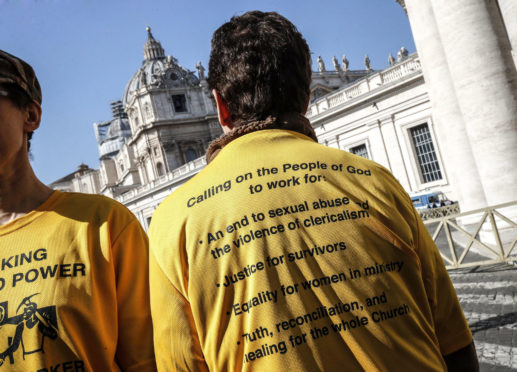Entering St Peter’s Basilica in Rome, a priest once told me, is like entering heaven.
Carved cherubim adorn the walls, while marbled pillars in tones of cream and honey soar upwards to golden frescoes on the ceilings.
Perhaps most beautiful in its simplicity is the Pietà, Michelangelo’s sculpture, carved in Carrara marble, depicting the broken body of Christ, slumped in his mother’s arms. It is a study of divine humility that captures so much of what it is to be human: the agony of cruelty; the beauty of love.
In St Peter’s square, where victims protested outside the Pope’s long-awaited summit on abuse, one young man was captured on television, tears running unabated down a face etched with pain, while an older woman stood silently, her hand on his shoulder. It was a Pietà for our times.
The victims, of course, had to be outside in the square, waiting like Lazarus for the crumbs from the toffs’ tables, as the Cardinals swept by in Gammarelli scarlet – the ecclesiastical equivalent of Versace. Irony of ironies, the victims’ summit contributions were by pre-recorded videos. It could hardly be otherwise in a church that has kept its broken at arm’s length from the bishops who have been shielded by three layers of defence: lawyers; insurance brokers; and the stone wall of their own denial.
Apparently, Cardinals wept as they watched the videos. Had they not listened before?
It was, therefore, with some anger that I read Pope Francis’s opening words to the summit about those who demand justice. It was acceptable, he maintained, to expose wrongdoing to rectify it. But, he continued, one cannot, “live an entire life accusing, accusing, accusing the Church.” Those who did, he said, were, “friends, cousins, relatives of the devil.”
That old trick! The Catholic church is second to none in its methods of silencing those it does not want to hear – and hurrah for German Cardinal, Reinhard Marx, for calling out their manipulation over secret, and destroyed, files – but few methods are more cruelly effective than equating the vocal with the devil. When you feel dirty and tainted, when you are riddled with guilt because you “failed” to stop your abuser, when you want benediction and salvation, there is nothing quite so damaging as the accusation that you are possessed. It is re-abuse.
The smell of sulphur is said to rise from the stanks in the church of St Peter’s. Pope Paul V1 once spoke about “the stench of Satan”, fearing the devil had infiltrated the Vatican. Pope Francis closed the summit saying not just the accusers but the abusers were “tools of Satan”. No matter the issue, in other words, it’s the devil. But blaming an external force for the stench, rather than looking within, will not do any more. No more smokescreens.
An abuse victim once told me that all she wanted was, “for the church to put its arms round me and tell me it was not my fault.” Victims just like her gathered at St Peter’s seeking that healing. The voice of the devil? No, the voice of the brave, holding to account an organisation that has abused in the name of Christ. If the shouts continue, perhaps it’s because the church keeps turning a deaf ear.
Australian bishop Mark Coleridge showed perspicacity. “We have shown too little mercy,” he said, “and therefore we will receive the same.”
Those who think that exposing the problem means it is somehow solved, should think again. In Scotland, the recommendations of the McLellan Commission continue to be publicly embraced but privately ignored. Last week, as the summit progressed, I attended a legal meeting with an abuse victim. “In every case,” their advocate told me, “you think common decency will kick in at some point. But it never happens. The Catholic Church continues to defend every action.”
Forgiveness, the Pope informed the summit, was paramount. But the funny thing about the Catholic church is that forgiveness is wheeled out most readily for its inner transgressors. It is less readily available to those outside its inner sanctum. Child abuser priests receive forgiveness and the Eucharist. Divorced or actively gay people do not. In any case, forgiveness is surely a response to full acknowledgement and repentance on the part of the transgressor. The church has fallen short on both counts. Don’t expect too much of the summit, the Pope warned. But we do. We must.
Michelangelo’s Pietà is behind glass now, worn away by hands reaching out to touch the stone. The church cannot similarly put itself behind glass, hiding from forensic examination.
It remains to be seen if the summit is just another public relations exercise by Catholic Church PLC. Healing will only take place when the church’s heart truly begins to feel what its head instructs its mouth to say. If, as we are told, the church is the body of Christ, it is currently the re-crucified body of Christ – and oh, that its hierarchy would show just a fraction of the surrender and humility of the broken son in his mother’s arms.
Catherine Deveney is an award-winning investigative journalist, novelist and television presenter











